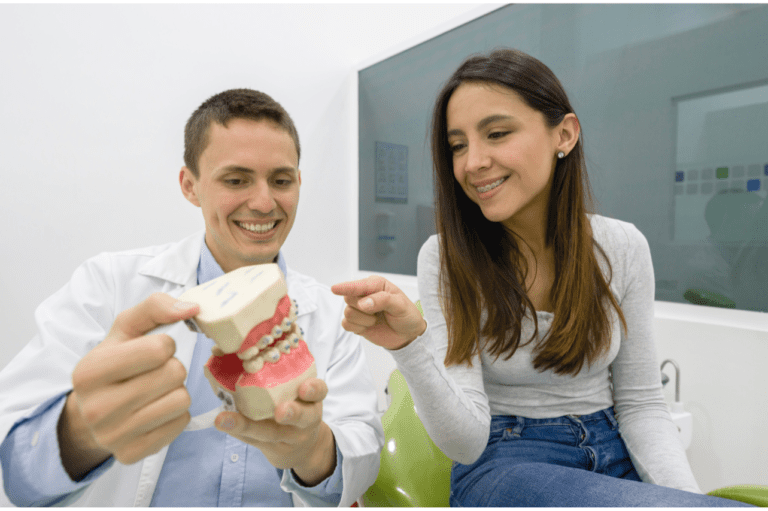
Brace yourself, this is a pretty extensive guide!
Excuse the pun, but if you’ve ever considered teeth straightening or been told by your dentist that you could benefit from orthodontic treatment, this post is for you.
I’m going to tell you all the need-to-know facts about teeth braces types so you can make a fully informed decision about what’s right for you.
So let’s get started!
Despite their less-than-glamorous image, dental braces are probably the most effective tool for moving teeth bar none!
Thankfully, over the past few decades, braces have become less visible and more comfortable to wear making them a popular choice for people of all ages.
There are essentially two types:
- Fixed, and
- Removable braces.
Moreover, there are also various makes and models of dental braces within these two categories.
Let’s look at each category type in closer detail and explore some of the options available.
Firstly fixed braces:

As the name suggests, fixed teeth braces are so called because they remain ‘fixed’ in the mouth for the duration of treatment.
Commonly known as ‘bracket and wire’, or ‘train-track’ style braces, they consist of a series of brackets that are glued to either the front or back of the teeth, along with metal or tooth-coloured archwires. These are threaded through the brackets to aid movement.
The archwires are then tightened using conventional elastic bands or ties, or in the case of self-ligating braces, utilising a built-in slide mechanism.
Either way, when force is applied to the appliance, it causes the teeth to move, little by little, over time.
So how do fixed braces move teeth?
Essentially, when sustained pressure is applied to the tooth, the periodontal ligament (the fibrous membrane that supports each tooth) is stretched on one side and compressed on the other. This action loosens the tooth slightly and new bone then grows to support it.
As a general rule of thumb, patients can expect to see minor movements approximately 4 weeks after fitting. Larger movements, however, take longer and wearers usually start to notice a real difference around 2-3 months.
Fixed teeth braces types
Fixed dental braces come in a variety of styles ranging from the standard metal (stainless steel) braces, we all know and recognise, to ceramic (tooth-coloured) appliances that are less visible, and lingual (incognito) braces that are worn behind the teeth for total anonymity.
If patients prefer, they can also opt for brightly coloured brackets and archwires, popular amongst children who want to make their braces a fashion statement.
In summary, there’s a fixed braces type to suit every need and requirement and costs will vary to reflect this.
So how good are fixed braces?
Essentially, if you have any type of teeth misalignment (malocclusion), fixed braces should be able to correct the problem. Misalignments can include:
- Crossbites
- Overbites
- Underbites
- Overcrowding
- Uneven spacing, and
- Diastemas
In some extreme cases, severe malocclusions are corrected using surgery, but on the whole fixed dental braces are the ideal orthodontic appliance to give you a straighter and healthier smile.
How long does teeth straightening take with fixed dental braces?
It depends upon the condition and severity of the malocclusion. For example, patients who simply want slight cosmetic adjustments might opt for fixed braces like C-Fast or Six-Month Smiles.
As the name suggests, these particular appliances are designed to correct stray teeth – in particular, the so-called ‘social six’ (the visible teeth you see when a person smiles), within 6 months or less.
Alternatively, for more complex tooth movements like crossbites and underbites, patients can expect to wear their braces for up to 3 years. However this depends upon the severity of the condition and the age of the recipient – some issues are easier to treat at a younger age when the jaw is still growing.
On average though, treatment takes around 18 months – 2 years to complete, so it isn’t a quick-fix solution.
Despite this, braces are growing in popularity. In the UK, for example, around 200,000 people get braces every year, and in the US that figure extends to 4.5 million, so more and more people are looking to straighten teeth.
What can patients expect during fixed braces treatment?
Typically, fixed braces may feel a little tight and uncomfortable when first worn and during the immediate days after an adjustment, but any discomfort normally disappears within a few days. Patients may also experience some slight tenderness in their teeth and gums. That said, any discomfort can usually be alleviated using over-the-counter pain relievers like Tylenol or Aspirin.
Finally, what about fixed braces cost?
In the UK, patients can expect to pay somewhere between £1500 – £5000, depending upon the type of treatment they have and the severity of their condition.
Children up to the age of 18 may also acquire metal-style braces for free on the NHS, as long as they are deemed medically necessary.
In the US, the average fixed braces cost falls somewhere between $3000 – $7500, although patients can expect to pay more for lingual (behind the teeth) braces and ceramic (tooth-coloured varieties).
Most dentists provide flexible financing options where treatment can be paid for over several months, so if you are considering dental braces, it’s worth talking to your local dentist about their payment plans.,
Clear aligners

The second of the teeth braces types are known as clear aligners and are different to fixed appliances in almost every way.
Clear aligners are essentially transparent plastic ‘mouthguards’ known as trays that are designed to fit snugly over the teeth. Typical examples of clear aligners include brands like:
- Invisalign,
- Clear Correct and
- CandidPro
These well-known brands are provided by your orthodontist or dentist, just like fixed braces.
Alternatively, there are also a growing number of companies offering clear aligners that you can purchase directly. These are known as ‘direct-to-consumer’ (DTC) aligners and include brands like:
- Smile Direct Club
- Byte, and
- uSmile
They differ from ‘in-office’ brands because they aren’t provided by your dentist and instead are ordered directly from the company, or, in some cases, from a dedicated store.
Invariably, whether you opt for aligners supplied by your dentist or direct-to-consumer brands, they differ greatly from fixed braces.
Here’s how…
- Firstly, clear aligners don’t contain any form of brackets or wiring, So when worn over the teeth, they’re hardly noticeable.
- Secondly, while fixed braces are attached permanently to the mouth, clear aligners are designed to be removed by the patient.
- Finally, where fixed braces involve a single appliance, clear aligner treatment utilises multiple appliances (trays).
So why is this?
Each aligner is custom-designed to move teeth around one-quarter of a millimetre. Once this is done, the aligner is discarded for the next one in the series which moves the teeth another quarter of a millimetre. This process continues until all the aligners are used and the patient has a straighter, healthier smile.
Movement works by harnessing the power of tension and compression that naturally occurs in the mouth. Each aligner is designed to manipulate those forces a small fraction to gradually shift teeth into their correct opposition.
Typically, a clear aligner patient will wear between 18 and 36 aligners to achieve a straighter, healthier smile, although this can vary depending upon the complexity of treatment.
So what about the results?
Essentially, clear aligners are best for fixing mild to moderate malocclusal corrections, in particular, cosmetic adjustments. For this reason, removable aligners are popular amongst teens and adults who want a straighter smile but don’t want the appearance of a ‘metal’ mouth while undergoing treatment.
Aligners aren’t, however, ideal in cases where teeth rotations of more than 20 degrees are required. If this is the case, fixed braces may work better.
What about the positives and negatives of clear aligners?
We’ve already mentioned that clear aligners are discreet and that’s the main reason that people choose them over other teeth braces types. However, other key advantages include:
- Better teeth cleaning – Because aligners are designed to be removed, they can easily be taken out before teeth are cleaned making oral hygiene easier.
- Flexibility – They don’t need to be worn 24/7 like fixed braces. Instead, they can be taken out for several hours a day, putting you in control of when and where you wear them.
On the flip side, patients considering clear aligners should understand that If aligners are not worn for a minimum of 20 to 22 hours a day, treatment can regress. Therefore a degree of self-discipline is required.
How long does clear braces treatment take?
Again, it varies depending upon the complexity of need but on average, clear aligner patients remain in treatment for 12-18 months. Sometimes it can be as little as 5-6 months but it can also be longer, up to 2 years or more.
So, what can patients expect during treatment?
Patients can expect a little discomfort particularly when inserting a new aligner. However, just like fixed braces, any discomfort should disappear after a few days, usually as soon as the teeth get used to wearing the new tray.
And finally, what’s the cost involved?
UK patients can expect to pay somewhere between £1300 and £5500 for dentist-provided aligners like Invisalign. In the US, that figure is somewhere between $3000 and $7500.
DTC aligners, however, are typically cheaper ranging from £685 or $850 through to £3500 or $4330 .
So there you have it, teeth braces types, key functions, differences, and what you can expect during and after treatment.
However unhappy you are with your current smile, the good news is that you don’t have to suffer with less than straight teeth as there are a variety of teeth straightening options that can help.
To find out more about about fixed braces or clear aligners, and which teeth braces type is best for you, talk to your local dentist for advice.
Many operate interest-free payment plans so getting a straighter, healthier smile isn’t so much of a financial burden right out of the gate.
I hope this post has helped and here’s to your smile journey!